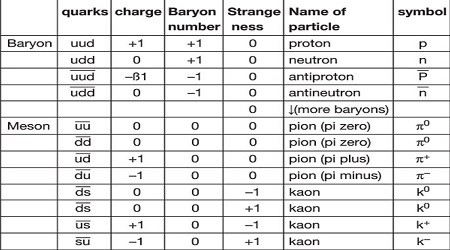Quarks, the fundamental constituents of matter, are enigmatic particles that serve as the building blocks for protons and neutrons—the very nuclei of atoms. Their composition, interactions, and behaviors invoke profound curiosity and demand investigation. This article delves into the intricate nature of quarks, exploring their classification, properties, interactions, and significance in the broader context of particle physics.
At the most fundamental level, quarks are elementary particles that belong to the category of fermions, which are particles that follow the Pauli Exclusion Principle. They are distinguished from other particles by their fractional electric charges, which come in three variations: +2/3 and -1/3, depending on the type of quark. There are six flavors of quarks known as up, down, charm, strange, top, and bottom. These flavors differ not only in their charge but also in their masses and interactions, with the up and down quarks being the lightest and most stable, constituting the majority of visible matter in the universe.
The up quark, possessing a charge of +2/3, combines with down quarks (which have a charge of -1/3) to form protons (uud) and neutrons (udd). This remarkable interplay of quark combinations not only illustrates the complexity of matter at a subatomic level but also underscores the importance of quark behavior in the universe’s very fabric. The formation of these baryons, which make up atomic nuclei, underscores their foundational role in the composition of ordinary matter.
Quark masses exhibit a fascinating disparity; the up and down quarks possess relatively low masses, around 2.2 MeV/c² and 4.7 MeV/c² respectively, making them lightweight entities. On the contrary, quarks such as the top quark, which is the heaviest with a mass of approximately 173 GeV/c², display a stark contrast in scale. This variance is not merely a peculiarity but plays a vital role in the dynamics and stability of matter. The mass of quarks is a crucial component of the mass of protons and neutrons, and consequently influences the mass of atoms as a whole—a fundamental characteristic that shapes the universe.
In addition to their electric charges, quarks are subject to the force of the strong interaction, which is mediated by particles known as gluons. Gluons, the carriers of the strong force, possess a unique quality; they are massless and do not only bind quarks together but also carry a type of charge known as color charge. The concept of color charge, a term that may seem deceptively simplistic, is essential to understanding the dynamics of quark interactions. Quarks possess three types of color charges—commonly referred to as red, green, and blue—while gluons themselves carry a combination of color and anti-color charge. This charge ensures that quarks are perpetually bound within hadrons, rendering them unobservable as free particles in nature.
The confinement of quarks within hadrons presents an intricate puzzle for physicists, as their interactions are governed by the principles of quantum chromodynamics (QCD). This theory describes how quarks and gluons interact and describes the nature of the strong force that binds them together. Intriguingly, as quarks come closer together, the strong force becomes asymptotically stronger, leading to a phenomenon known as “color confinement.” This ensures that quarks are perpetually confined within larger particles and cannot exist independently under normal conditions. It is this confinement that contributes to the stability of atomic nuclei and, by extension, the matter that populates the observable universe.
Beyond confinement, quarks exhibit another striking property: flavor-changing interactions, governed by the weak force. This interaction allows quarks to transform from one flavor to another through the mediation of W and Z bosons, which are responsible for processes such as beta decay. During beta decay, a down quark may change into an up quark, while simultaneously emitting a W- boson, thus transforming a neutron into a proton. Such flavor transitions contribute to the intricacies of particle interactions and the mechanisms underpinning nuclear reactions.
The exploration of quarks transcends theoretical bounds, leading to experimental revelations. High-energy particle colliders, like the Large Hadron Collider (LHC), attempt to probe quark interactions by smashing protons together at nearly the speed of light. These experiments have not only corroborated the existence of quarks but have also confirmed the existence of the Higgs boson, revealing the profound connection between particle mass and the Higgs field. The discovery of the Higgs boson in 2012 was monumental; it not only validated the Standard Model of particle physics but also provided insights into how quarks acquire their mass, bridging theoretical frameworks with empirical evidence.
As we explore the depths of quark composition and their role in the universe, it becomes apparent that these minuscule particles are far more than just building blocks of matter. They embody the complexities of fundamental forces, the elegance of symmetry, and the profound interconnectedness of cosmic existence. Understanding quarks not only unravels the mysteries of subatomic physics but also prompts further inquiry into the realms of dark matter and the ultimate fate of the universe.
In conclusion, quarks, as integral components of matter, invite us to reconsider our understanding of the physical world. Their composition, interactions, and implications unify theoretical concepts with experimental validation, revealing a universe rich in complexity and wonder. The intimate dance of quarks within hadrons illuminates the pathways of reality we inhabit, encouraging continued exploration in the pursuit of knowledge that transcends generations.












